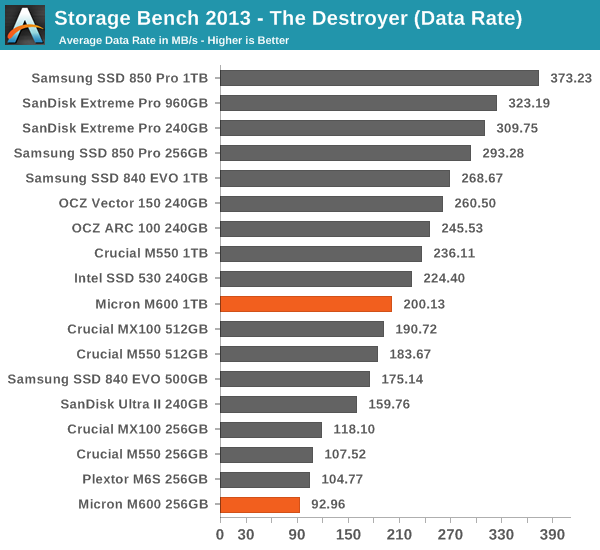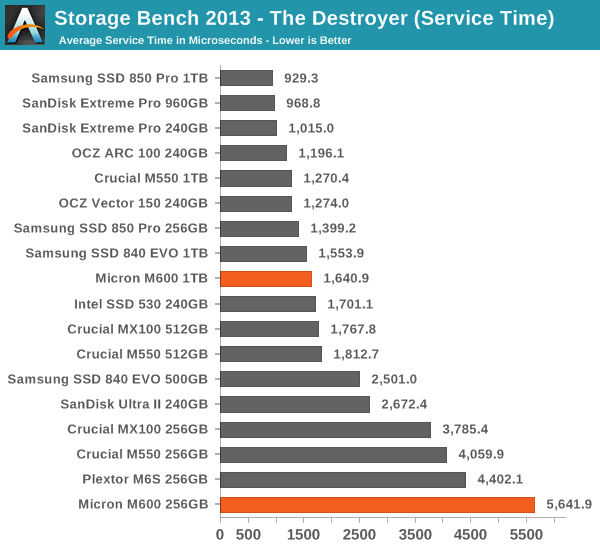Micron M600 (128GB, 256GB & 1TB) SSD Review
by Kristian Vättö on September 29, 2014 8:00 AM ESTAnandTech Storage Bench 2013
Our Storage Bench 2013 focuses on worst-case multitasking and IO consistency. Similar to our earlier Storage Benches, the test is still application trace based – we record all IO requests made to a test system and play them back on the drive we are testing and run statistical analysis on the drive's responses. There are 49.8 million IO operations in total with 1583.0GB of reads and 875.6GB of writes. I'm not including the full description of the test for better readability, so make sure to read our Storage Bench 2013 introduction for the full details.
| AnandTech Storage Bench 2013 - The Destroyer | ||
| Workload | Description | Applications Used |
| Photo Sync/Editing | Import images, edit, export | Adobe Photoshop CS6, Adobe Lightroom 4, Dropbox |
| Gaming | Download/install games, play games | Steam, Deus Ex, Skyrim, Starcraft 2, Bioshock Infinite |
| Virtualization | Run/manage VM, use general apps inside VM | VirtualBox |
| General Productivity | Browse the web, manage local email, copy files, encrypt/decrypt files, backup system, download content, virus/malware scan | Chrome, IE10, Outlook, Windows 8, AxCrypt, uTorrent, Ad-Aware |
| Video Playback | Copy and watch movies | Windows 8 |
| Application Development | Compile projects, check out code, download code samples | Visual Studio 2012 |
We are reporting two primary metrics with the Destroyer: average data rate in MB/s and average service time in microseconds. The former gives you an idea of the throughput of the drive during the time that it was running the test workload. This can be a very good indication of overall performance. What average data rate doesn't do a good job of is taking into account response time of very bursty (read: high queue depth) IO. By reporting average service time we heavily weigh latency for queued IOs. You'll note that this is a metric we have been reporting in our enterprise benchmarks for a while now. With the client tests maturing, the time was right for a little convergence.

Wow, this actually looks pretty bad. The 256GB M600 is slower than the 256GB MX100 and I guess it is due to the fact that under sustained workloads, the M600 will have to transfer data from SLC to MLC at the same time it is taking in host IOs, so the performance drops due to the internal IO overhead. The 1TB drive does better thanks to higher parallelism, but even then the M550 and 840 EVO are faster.











56 Comments
View All Comments
milli - Monday, September 29, 2014 - link
The MX100 already had terrible service time. The M600 is even worse.I mean if it's even worse than this showing the MX100 delivered (http://techreport.com/r.x/adata-sp610/db2-100-writ... then forget about it.
milli - Monday, September 29, 2014 - link
http://techreport.com/r.x/adata-sp610/db2-100-writ...Link got messed.
BedfordTim - Monday, September 29, 2014 - link
If service times are such an issue why did Tech Report give the MX100 an Editor's Choice award?milli - Monday, September 29, 2014 - link
Because everybody is a sucker for low prices.menting - Monday, September 29, 2014 - link
i guess you go out and buy the fastest, regardless of price then?milli - Monday, September 29, 2014 - link
Obviously not. I'm just giving one of the main reasons why the MX100 wins so many awards.Samus - Monday, September 29, 2014 - link
It's still a better drive than competing products in its price segment. The only other drive that comes close is the 840 Evo (which apparently has some huge performance bugs on static data - and support is terrible...the bug has existed for over a year.)You could consider spending more money on an Intel drive or something from Sandisk, but most consumers need something "reliable-enough" and price is always the driving factor in consumer purchases. If that weren't true, you wouldn't see so many Chevy Cobalt's and Acer PC's.
The irony is, for price and reliability, the best route is a used Intel SSD320 (or even an X25-M) off eBay for $60 bucks. They never fail and have a 15 year lifespan under typical consumer workloads. They're still SATA 3Gbps, but many people won't notice the difference if coming from a hard disk. Considering the write performance of many cheap SSD's anyway (such as the M500) the performance of a 4 year old Intel SSD might even still be superior.
Cellar Door - Monday, September 29, 2014 - link
My X-25M failed after 2 years of use. So please don't use the word 'never' - Intel sent me a 320 as a replacement, due to 3 year warranty. Performance wise, it's ancient but still an ssd.Samus - Monday, September 29, 2014 - link
Like many SSD's, they are prone to failure from overfapping.Lerianis - Friday, October 3, 2014 - link
Eh? Overwriting, I think you mean. That said, all of these drives should be able to handle 20GB's write per day at least for years without issues.